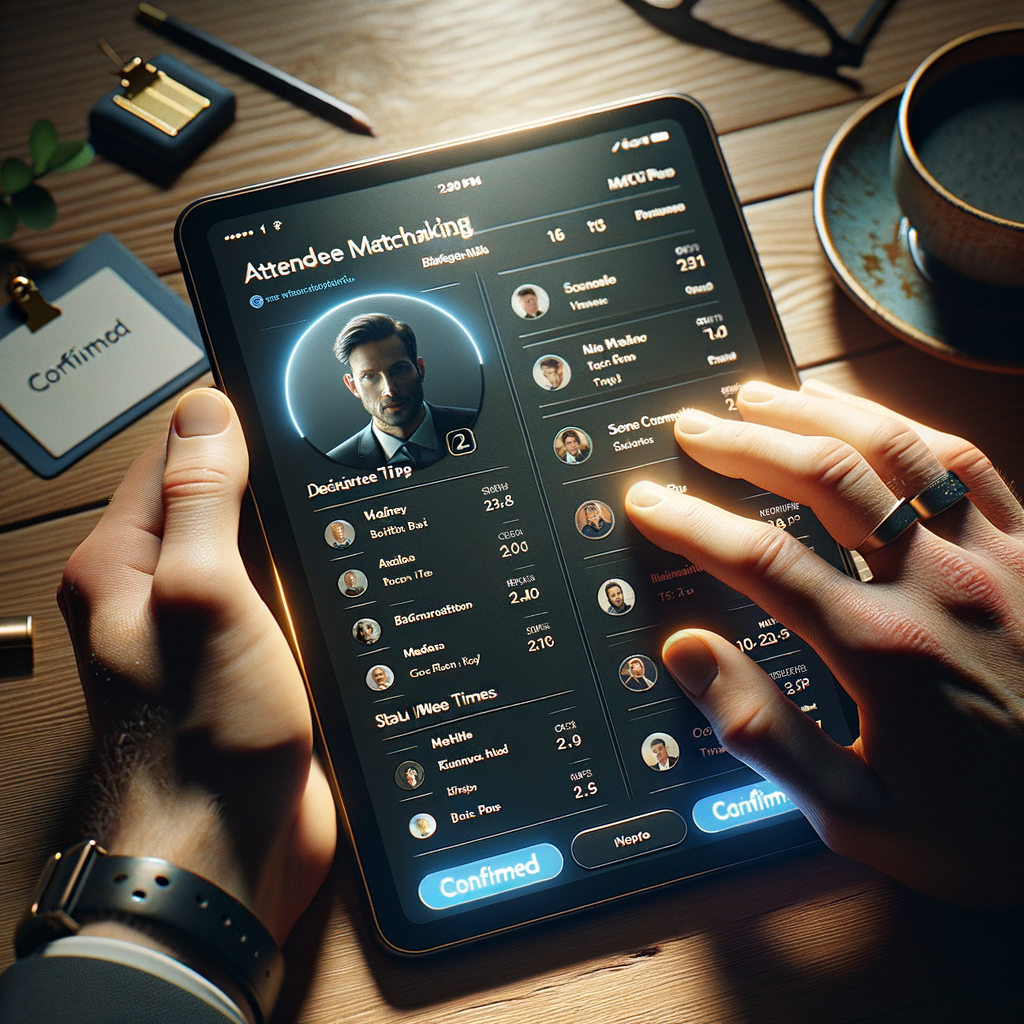Buy Curated Attendee Matchmaking To Turn Events Into Pipeline
How I use SharePro curated attendee matchmaking to turn networking into booked sales meetings, cut no-shows, and prove event ROI with clear steps.
Buy Curated Attendee Matchmaking To Turn Events Into Pipeline
I used to walk trade show floors, happy hours, and virtual mixers with a pocket full of business cards and a hopeful smile. Now I walk in with a calendar already stacked with qualified buyer conversations. The difference is simple and measurable: I buy curated attendee matchmaking on SharePro, where vetted providers secure meetings with the right people, confirm attendance, and convert my networking hours into a predictable sales pipeline. Instead of gambling on chance encounters, I treat events like a go to market channel with clear inputs, outputs, and ROI.
Curated attendee matchmaking is not a list broker, it is a done for you service that aligns event attendee intent with my ideal customer profile, then schedules and confirms meetings before I show up. A good provider uses firmographic data, role seniority, buying signals, and topic interests pulled from event apps, sponsor lists, past registration data, and public profiles. They do the human work I cannot scale, like reading session agendas to infer projects people care about, or messaging in the attendee portal to secure time on the calendar. The outcome is not just contacts; it is a time boxed conversation with a qualified person who agreed to talk about a specific problem I solve.
The reason I pay for this is because qualified matches beat serendipity by a mile. In an unstructured networking hour, I might meet ten people and discover two with potential fit. With curated matchmaking, I start with nine out of ten who already fit my ICP, and most of them show up on time. Show rate is the quiet killer of event ROI, and it is where professional matchmakers earn their fee. They double confirm, send reminders, drop calendar holds, and keep a waitlist to backfill last minute drops. I do not want more conversations; I want the right conversations that turn into pipeline, and curated matchmaking gives me that leverage.

SharePro makes this approach scalable. Instead of reinventing outreach tactics for each conference, I browse specialized providers on the marketplace who already know the event verticals, the tools, and the attendee channels. Each listing outlines the number of matches, the qualification rules, the show rate commitment, and what happens when someone no shows. I can choose simple intro brokering for small meetups, or high touch white glove for flagship trade shows, including on site shepherding to walk prospects to my booth or table. Most importantly, all the communication, milestones, and payments live on platform, which protects my budget and sets clear delivery standards.

When I evaluate providers, I start with clarity. I look for a crisp definition of a qualified match, ideally tied to firmographics like company size and industry, demographics like role and seniority, and psychographics like active projects or pains expressed in session agendas. I want to see the outreach playbook they will use. Are they messaging through the event app, LinkedIn, email, or all three, and how do they avoid spammy blasts. I also check their no show mitigation plan, including how early they put calendar slots on hold, how many reminder touches they send, and whether they offer a replacement for a missed meeting within a defined time window. If a listing includes anonymized transcripts or screenshots of previous confirmations, even better.
My ROI model for curated matchmaking is straightforward and helps me compare offers apples to apples. I calculate cost per held meeting by dividing the total service fee by the number of meetings that actually happen, not just scheduled. Then I map historical conversion rates from first meeting to qualified opportunity, and from opportunity to closed won. Pipeline value per held meeting is the product of those conversion rates and my average deal size. For example, if I pay 2,000 dollars for 12 held meetings, that is about 167 dollars per meeting. If 30 percent become opportunities and 25 percent of those close at 8,000 dollars, then each held meeting is worth 600 dollars in expected revenue. That is a 3.6x efficiency on meeting cost before I even factor in lifetime value or cross sell. If expected revenue per meeting exceeds cost by a healthy margin, I buy.
Operationally, I set up each engagement like a micro campaign. I share my ICP and disqualification rules, sample discovery questions, a crisp one sentence value proposition in plain language, and two or three meeting titles prospects will understand. I give the provider a short set of assets such as a one page, a customer quote relevant to the event theme, and a booking link that routes to a protected calendar reserved for the event. We align on preferred meeting lengths and buffers, whether I want cluster scheduling at a booth or quiet meeting tables, and how to capture consent for follow up in the CRM. The clearer I am upfront, the better the matches and the smoother the day.
Reducing no shows is its own discipline, and it starts with double opt in consent. I ask providers to get an explicit yes from the prospect, then send a calendar invite with the event name, the exact location or meeting link, and a short agenda in the description. I request a friendly reminder sequence, typically a two day email, a one day SMS if allowed, and a one hour ping. At physical venues, wayfinding matters, so I include hall numbers, booth coordinates, and a photo of the spot. If I offer a useful incentive, it is something aligned with the buyer problem, like a mini audit or quick setup, rather than generic swag. Finally, I plan a backfill policy so an empty slot can be replaced by a waitlisted attendee.
On site, I run meetings like a relay, not a marathon. I keep them to 15 or 20 minutes with five minute buffers to write notes and move on time. If the provider offers an on site concierge, I use them to guide prospects from the entrance to my meeting table, which dramatically improves punctuality. I use a mobile CRM note template to capture context, pain points, decision process, and agreed next steps. If someone is not a fit, I do not try to stretch the conversation; I thank them and free the slot. If someone is a strong fit but needs more time, I book a virtual deep dive within 48 hours instead of going long on the show floor.
The follow up is where pipeline becomes forecast. I send a same day or next morning email that recaps the problem we discussed and confirms the next step, with a link to reschedule if needed. I tag each contact with an event code and the provider name so I can analyze performance later. Within a week, I review show rate, conversions to opportunity, average deal size, and the velocity from first meeting to next step. I compare these numbers to past events without curated matchmaking. In nearly every case, my cost per qualified opportunity drops, and the event ROI is easier to defend in budget conversations because the evidence is clean and time stamped.
Different creators and small businesses benefit in different ways. A SaaS founder can stack 15 discovery calls with directors who own the problem. A freelancer can pre book coffee chats with decision makers who buy services on short cycles. An artist can line up buyer or curator meetings tied to specific collections, avoiding hours of vague small talk. A marketplace seller can meet verified distributors during a show and convert a handful of wholesale orders on the spot. In each case, curated matching turns unstructured hustle into a planned sequence of meaningful conversations.
Because I am buying a service in a marketplace, I treat due diligence seriously to avoid scams or under delivery. I read provider reviews and look for patterns in feedback rather than isolated praise. I check whether they keep communication on platform, which is where milestones and dispute resolution protect me. I insist on clear deliverables, such as held meetings rather than introductions only. If a provider refuses to specify what counts as a qualified match or pushes me off platform for payment, I walk. The goal is not to squeeze vendors, it is to align incentives so both sides win when meetings show and deals advance.
Pricing models vary, and I pick the one that aligns with my risk tolerance. Some listings charge per scheduled intro, others per meeting held, and some include a bonus for meetings that progress to a second call. For high stakes shows, I negotiate a cap on total cost and a minimum number of held meetings, with a replacement window for no shows. I ask for a simple service level agreement in plain language covering qualification rules, show rate targets, communication cadence, data handling, and how we will report results. Nothing fancy, just enough clarity to keep expectations tight and collaboration smooth.
I always circle back to ROI. Events can be noisy, expensive, and full of distractions, but curated attendee matchmaking brings signal. When I can book fifteen meetings with people who look like my best customers, and eleven of them show up, my time suddenly compounds. My sales calendar fills with intent, my follow up writes itself, and my pipeline forecast stops being a guess. That is what I buy on SharePro: not a pile of names, but momentum.
Conclusion
If you want your next networking event to feed real pipeline, stop hoping for luck and start buying results. Use SharePro to hire a provider who will define qualification rules, secure confirmations, protect show rates, and measure outcomes. Evaluate offers by cost per held meeting, expected conversion, and deal value, then invest where the math is obvious. With curated attendee matchmaking, every hour you spend at an event can become a booked sales meeting and a clean line in your ROI report.
Blog Article Tags
curated attendee matchmaking sharepro event marketing lead generation sales pipeline networking services event roi b2b marketing no-show reduction marketplaceMore Articles
Maximizing Your Reach: Effective Social Media Strategies for Indie Creators - Discover actionable social media strategies for indie creators to engage fans, grow your audience, and increase support across disciplines.
Transform Your Brand Storytelling with Custom Character Animations - Elevate your brand narrative and engage your audience with bespoke character animation. Discover how visual storytelling on SharePro Marketplace can drive conversions.
Maximize Your Brand’s Impact with Authentic Beauty & Fashion Influencer Collaborations - Learn how genuine beauty and fashion influencer partnerships can elevate your brand, build trust, and increase sales using authentic content and targeted audiences.
How Professional Product Photography Boosts Conversions and Builds Trust for Your Online Store - High-quality product images increase sales, enhance credibility, and create a compelling shopping experience for your e-commerce customers.
How Custom Explainer Videos Accelerate Customer Trust and Boost Conversion Rates - Uncover how custom explainer videos from SharePro simplify complex concepts, build customer trust, and drive sales conversions with compelling storytelling.


